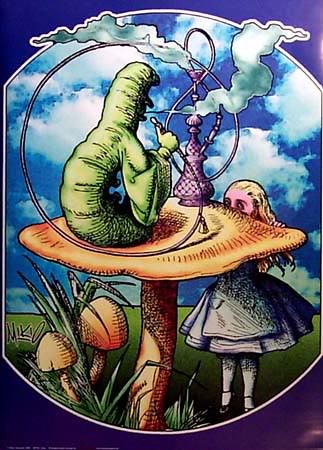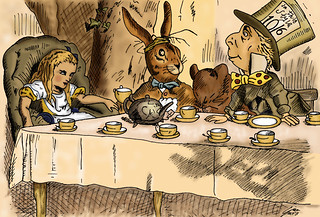
Alice in Wonderland or Alice’s Adventures in Wonderland is a novel published in 1865 written by Charles Lutwidge Dodgson under the pseudonym Lewis Carroll. “It tells of a girl named Alice who falls down a rabbit hole into a fantasy world populated by peculiar, anthropomorphic creatures. The tale plays with logic, giving the story lasting popularity with adults as well as with children” (literature.org). Alice in Wonderland has been adapted into many theatrical and screen versions, most famously, Walt Disney’s version produced in 1951. The novel was recently turned into a television series on ABC titled Once Upon a Time in Wonderland. The novel was also referred to in Jefferson Airplane’s famous song “White Rabbit”.
 Although it is evident that the story has held popularity with children and adults for many years, Dodgson’s work has been challenged and banned multiple times since its publication. The novel is most often challenged for its alleged promotion of drug use. The most controversial scene takes place after Alice enters Wonderland and meets the philosophic caterpillar. The caterpillar sits atop a mushroom, smoking a hookah, offering Alice advice on how to find the white rabbit. He also provides Alice with a piece of the mushroom that will alter her size to help her on her journey. The presence of the hookah and the body altering and allegedly mind altering mushroom enraged academic institutions, parents, and religious groups. This outrage led to the book being banned in the United States during the 1960s.
Although it is evident that the story has held popularity with children and adults for many years, Dodgson’s work has been challenged and banned multiple times since its publication. The novel is most often challenged for its alleged promotion of drug use. The most controversial scene takes place after Alice enters Wonderland and meets the philosophic caterpillar. The caterpillar sits atop a mushroom, smoking a hookah, offering Alice advice on how to find the white rabbit. He also provides Alice with a piece of the mushroom that will alter her size to help her on her journey. The presence of the hookah and the body altering and allegedly mind altering mushroom enraged academic institutions, parents, and religious groups. This outrage led to the book being banned in the United States during the 1960s.
In the early 1900s the state of New Hampshire banned the book from all public schools because the novel was accused of promoting sexual fantasies and masturbation. This accusation most likely refers to the questionable sexual activities of the author, not the novel’s content.
 The novel has also been challenged for its use of talking animals, which were deemed an abomination in the sight of God by many religious institutions. In 1931 the Governor of the Hunan Province in China banned the book for the same reasons arguing that “animals should not use human language, and that it was disastrous to put animals and human beings on the same level”. This accusation is a common defense for censorship of books, as you will see in our next blog on Winnie the Pooh.
The novel has also been challenged for its use of talking animals, which were deemed an abomination in the sight of God by many religious institutions. In 1931 the Governor of the Hunan Province in China banned the book for the same reasons arguing that “animals should not use human language, and that it was disastrous to put animals and human beings on the same level”. This accusation is a common defense for censorship of books, as you will see in our next blog on Winnie the Pooh.
To read more on why Alice in Wonderland is on the American Library Association’s top 100 banned books list click here.
To see our exhibit featuring Alice in Wonderland visit the Department of Special Collections located on the 5th floor of McFarlin library, open to the public Monday-Friday 8-5.
